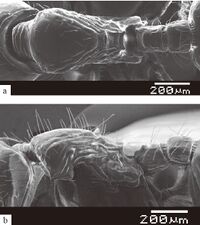Myrmecina breviata
| Myrmecina breviata | |
|---|---|

| |
| Scientific classification | |
| Kingdom: | Animalia |
| Phylum: | Arthropoda |
| Class: | Insecta |
| Order: | Hymenoptera |
| Family: | Formicidae |
| Subfamily: | Myrmicinae |
| Tribe: | Crematogastrini |
| Genus: | Myrmecina |
| Species complex: | macrops |
| Species: | M. breviata |
| Binomial name | |
| Myrmecina breviata Okido, Ogata & Hosoishsi, 2020 | |
Nothing is known about the biology of Myrmecina breviata.
Identification
Okido, Ogata, and Hosoishi (2020) - A member of the macrops complex (M. breviate, Myrmecina gymnocephala, and Myrmecina macrops). Within this complex M. breviate is distinguished by its angulately projected propodeal spine.
Keys including this Species
Distribution
Distribution based on Regional Taxon Lists
Indo-Australian Region: Philippines (type locality).
Distribution based on AntMaps
Distribution based on AntWeb specimens
Check data from AntWeb
Countries Occupied
| Number of countries occupied by this species based on AntWiki Regional Taxon Lists. In general, fewer countries occupied indicates a narrower range, while more countries indicates a more widespread species. |

|
Biology
Castes
Nomenclature
The following information is derived from Barry Bolton's Online Catalogue of the Ants of the World.
- breviata. Myrmecina breviata Okido, Ogata & Hosoishsi, 2020: 26, fig. 9 (w.) PHILIPPINES.
Unless otherwise noted the text for the remainder of this section is reported from the publication that includes the original description.
Description
Worker
Holotype. TL 2.60, HL 0.65, HW 0.61, CI 94, SL 0.61, SI 100, PW 0.42, ML 0.70. Paratype. TL 2.59, HL 0.66, HW 0.64, CI 98, SL 0.59, SI 93, PW 0.42, ML 0.70 (1 measured).
Head subrectangular, as long as broad in full-face view; median portion of occipital margin flattened; occipital corners widely rounded, not projected posteriorly. Masticatory margin of mandible bent at midlength (third small tooth or sixth tooth); apical tooth strong, third tooth robust, followed by 5 small teeth and a stout basal tooth bearing blunt apex; small teeth unclear. Dorsal surface of clypeus slightly concave; median portion of anterior margin weakly projected with a median process but the process frequently unclear; lateral portion simple, lacking sharp ridge in front of antennal insertions. Anterior dorsal surface of labrum with paired small denticles distinctly, closed to each other. Frontal carinae very short, frequently unclear, running to about mid point level of eyes. Eyes extremely large and convex, varying in size with maximum diameter 0.15-0.16 mm and 7-8 ommatidia; malar space as long as diameter of eye in profile. Antennal scape long, extending beyond posterolateral corner of head distinctly; antennal flange weakly developed.
Dorsal outline of mesosoma slightly convex in profile. Pronotum without denticles; anterior ventrolateral portion not angulate. Eumetanotal spine absent. Propodeal spine only angulately projected, not spine-like. Propodeal lobe feebly raised. Propodeal spiracle large, situated near base of propodeal spine, distance between posterior margin of spiracle and posterior margin of propodeum slightly longer than diameter of spiracle. Petiole long, longer than high in profile, and longer than broad in dorsal view; small but distinct dorsal crest located almost at midlength in profile; subpetiolar process absent or unclear; ventral outline flattened or slightly convex. Postpetiole broader than petiole in dorsal view; anterior side corners rounded; dorsal outline slightly convex or flattened in profile; ventral outline projected rectangularly.
Anterior margin of gaster not concave in dorsal view. Head smooth and shining; ventrolateral portion smooth and shining.
Mandibles smooth and shining, frequently yellow spots on dorsal surface. Clypeus smooth and shining. Mesosoma largely smooth and shining, lateral portion with a few longitudinal rugae on dorsum. Petiole with shallow rugae. Postpetiole smooth and shining on dorsum. Head with sparse pilosity on dorsum. Mesosoma with sparse pilosity on dorsum. Pilosity of pronotum slightly shorter than maximum diameter of eye. Pilosity of petiole and postpetiole as long as that of mesosoma. Petiole without hairs on ventral surface. Postpetiole with about 4 hairs on ventral surface. Head, mesosoma, petiole and postpetiole reddish brown, gaster slightly darker than head and mesosoma.
Type Material
Holotype worker, PHILIPPINES: Luzon, Lagunas, Mt. Makiling, 21. xi. 1995 (I. Löbl) (The Natural History Museum). Paratype. 1 worker with same data as holotype (The Natural History Museum).
